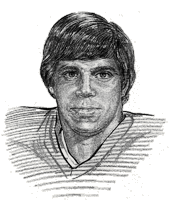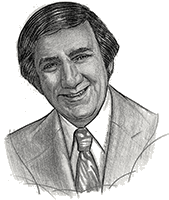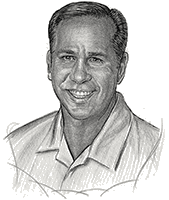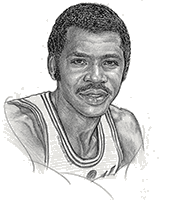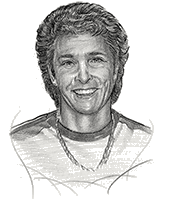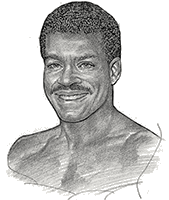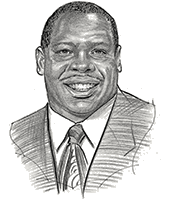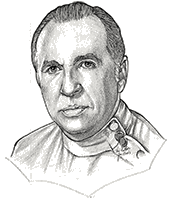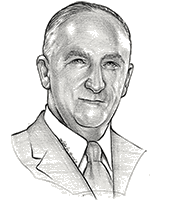He walked into his first Cleveland Browns camp in 1975 as a non-drafted free agent from Duke University where he had undergone five position shifts before the Blue Devils anointed him an offensive tackle in his junior year. It didn’t take the Browns nearly that long to decide the one-time North Carolina high school quarterback sensation was a guard, and by the eighth game of his rookie season he had settled in as a starter. That was the beginning of an 11-year run as a key player on some of the strongest offensive lines in Browns history. During those 11 seasons he missed only two games, was named Browns’ Man of the Year in 1981 and was selected to co-captain the 1985 team with future Hall of Famer Ozzie Newsom. He retired after the 1985 season to enter the insurance business, subsequently forming a partnership with Browns teammate (and now fellow Greater Cleveland Sports Hall of Fame member) Doug Dieken to create a highly successful insurance agency in suburban Westlake. He makes his home in Bay Village, where has managed to fit a volunteer high school coaching job into a busy schedule of community and charitable activities.
On a quiet news day in 1968, unsuspecting Greater Clevelanders were mildly surprised to learn that a little-known local attorney had purchased the Cleveland Arena and its prime tenant, the Cleveland Barons of the American Hockey League. Little did they know they were reading the opening chapter of a local sports saga which in the next decade would see the construction of the largest sports empire in the city’s history, with surprises galore to come. The ink had barely dried on the Arena purchase papers when Nick Mileti set out to lure an NBA expansion team to his new building. In 1970 he was rewarded with a team he named the Cleveland Cavaliers and dressed in the Wine and Gold colors of his alma mater, John Adams High. Next, he turned his eyes to the Cleveland Indians, who were openly seeking greener fields. Teaming with a group of civic activists, he purchased the team on March 22, 1972 for $9 million. A month later, learning the Calgary Broncos of the newly-formed major league-conscious World Hockey Association would be shifted because of financial woes, he bought the franchise, shuffling the minor league Barons off to California. Now, with two indoor sport teams in his bulging major league stable, he turned his attention to replacing the aging Arena with a state-of-the-art big league home. Unable to work out an arrangement for a site in the City of Cleveland, he pulled off his climactic sports surprise by building the opulent 22,000-seat Coliseum midway between Cleveland and Akron on a site in Richfield literally surrounded by cornfields. He opened the building with a gala Frank Sinatra concert in 1974. The empire would slowly dissolve after that, but when he left Cleveland in 1979 for Beverly Hills to produce and finance plays and motion pictures, he left behind him Indians and Cavaliers teams whose presence would serve as the impetus for the construction of a new downtown sports complex forever altering the heart of downtown Cleveland.
Deceased 2024
He came to Cleveland from Mississauga, Ontario, Canada in 1983 to play for pay for Cleveland’s professional indoor soccer team, the Cleveland Force. His rookie season left ample room for improvement, covering five games and producing one assist. His chance to redeem himself would be a long time coming. It would be six years, and stints with the Minnesota Strikers and Los Angeles Lazers, before he would appear again in a Cleveland uniform as a member of the renamed Cleveland Crunch. It would prove to be an historic reunion, one which would last 15 years and enable him to make a convincing case for a permanent place on a list of the city’s all-time time finest athletes. When the case was closed in 2004 there was no disputing the verdict. The evidence included 1,223 goals and 761 assists in 685 regular season games, another 224 goals and 104 assists in playoff games, six league MVP awards, and election to 14 All-Star teams. Fourteen times he helped lead his team into playoffs and three times—in 1994, 1996 and 1999—to the championship of the National Professional Soccer League. The first of those titles, in 1994, marked Cleveland’s first in any professional sport since the Cleveland Browns’ NFL championship in 1964. When he retired as the all-time leading scorer in professional indoor soccer, he had for some time been generally acclaimed as the best indoor soccer player in U.S. history. In May of 2005, the Major Indoor Soccer League cemented that claim by announcing its Most Valuable Player Award would henceforth be known at the Hector Marinaro Trophy. The popular Marinaro elected to remain in Cleveland after his retirement and currently makes his home in Brunswick with his wife, Jodi, and their two children.
In an era when 6-6 high school basketball centers were considered premium “big men” East High School’s 6-8 Emanuel “Manny” Leaks was both giant and giant-killer. By the end of his senior season in 1963-64, he had earned a prominent place for himself on an impressive list of East High stars. His fierce rebounding and steady scoring provided the twin engines which propelled the Blue Bombers all the way to the finals of the ’64 Ohio AA (large schools) championship game and himself to All-Scholastic, All-Ohio and Parade Magazine All-American honors. En route to the state title game, East recorded its third win of the season over East Tech in the regional championship game, ending a string of six straight Scarab appearances in the state finals. The Blue Bombers then obliterated Elyria 58-31 in the state semi-final game before losing to Dayton Belmont in the final. Continuing his career at Niagara University, where he would be teamed in his final season with future immortal Calvin Murphy, he carved out a large place for himself in the Purple Eagles’ record book. Thirty six years after his final season in 1967-68, Leaks still ranks second on the school’s career rebounding list with 1087, holds three of its top 10 season rebounding marks, three of its single game rebounding highs, and is 18th on the career scoring leaders’ list with 1,243 points, an average of 17.3 per game. He went on to play six pro seasons with four different ABA teams and a pair of NBA clubs. His finest effort came in 1969-70 when he averaged 18.8 ppg and 12.5 rebounds for the Dallas Chaparrals in the ABA. Now a real estate investor, he resides in Cleveland.
One of the finest all-around female athletes ever to come out of Cleveland, Sue Koziol starred in basketball at Lincoln-West High and later at Cleveland State where she established a peach basket full of records and also managed to work in a school record javelin toss in track. When she elected to test the arm that enabled her at age 14 to set a Junior Olympics Softball Throw record of 232 feet in flag football, she quarterbacked her Hennie Homes team to seven national titles, winning seven Offensive MVP awards along the way. But it was as a softball shortstop that she rose to the heights of the extraordinary. Already a recognized star in the sport when she began playing for Cleveland State, she led the Vikings to the OAISW Regional Championships and a spot in the national tournament, earning first team All-American honors in 1982 while also garnering the first of her four awards as the team’s Most Outstanding Player. After her graduation in 1986 through 2001 she would win a total of 13 Women’s Class “A” All-World All-American awards while competing in the U.S. Slow Pitch Softball Association and ASA, and playing on six USSA national championship teams. She was selected the MVP of the USSA World Series in 1987, 1989 and 1992 and the MVP of the National Triple Crown Championship Tournament in 1992. Capping her career, she was chosen in 1993 for the USSSA’s All-Time All-World Team, one of just 12 players to be so honored. She is currently living in Cleveland and teaching and coaching at Lincoln West.
On a red letter day for amateur wrestling in the U.S in 1971, Chardon Hilltopper freshman Leroy Kemp decided he was not cut out to be a basketball player and grudgingly decided to give wrestling a try. But his interest grew after attending a wrestling camp where several U.S Olympians were training for the 1972 Summer Games. The result: in his last two seasons at Chardon, he went 55-0, won two Ohio Division II championships and a High School Junior Nationals title in 1974 and posted a rare American victory against a member of the Soviet Junior National Team when it stopped in Cleveland on a U.S tour At the University of Wisconsin he added three NCAA Division I 158-lb. titles and built a 143-6-1 record which included 87 consecutive wins and a 103 match unbeaten string. In his first international tournament in 1978, at 21 years and eight months he became the youngest American to win a gold medal at the World freestyle championships and eventually became the first American to win three World titles by adding golds in 1979 and 1982. He added Pan-American Games titles in 1979 and 1983 and seven national freestyle titles to become one of the most decorated matmen in U.S. history. Inducted into the National Wrestling Hall of Fame in 1990, he now lives in Forest Lake, MN.
For a half-dozen unforgettable years, Carol Heiss Jenkins was the greatest ladies figure skater in the world. She was World Champion in 1956-57-58-59 and 60, U.S. Champion in 1957-58-59 and ’60, Olympic Silver Medalist in 1956, and finally the Olympic Gold Medalist in 1960. Her marriage to another Olympic Champion, Hayes Jenkins, in 1956 brought her to Akron, and when her family was raised she returned to the ice as a teacher. That in turn led her to the Winterhurst Rink in Lakewood in 1981, where she began a program which has brought national prominence to the modest facility and established the Greater Cleveland area as one of the nation’s leading figure skating centers. In her tenure at Winterhurst she has coached such internationally-ranked skaters as Lisa Ervin and Timothy Goebel, Greater Cleveland natives Tonia Kwiatkowski and Jeni Meno, and 2001 National Men’s Junior National Champion Parker Pennington. In 1996 the United States Figure Skating Association and Professional Skating Association named her Coach of the Year. It is for these accomplishments as a coach and goodwill ambassador for Greater Cleveland that Jenkins, now a resident of Westlake, has been selected to the Greater Cleveland Sports Hall Of Fame.
Native Clevelander Tom Jackson launched his illustrious football career at John Adams High where he starred for two seasons before moving on to the University of Louisville in 1969. After winning Missouri Valley Conference Player of the Year honors as a sophomore in 1970 and as a senior in 1971, he began a history-making 14-year career with the Denver Broncos of the NFL in 1973. When his career ended, he had played the most games (191) in Broncos history, a total since surpassed by John Elway, who is also the only player to have played more seasons (16) with Denver. Jackson made three consecutive Pro Bowl appearances from 1977 through 1979, was named All-Pro in 1977 and 1978 and was the Broncos defensive MVP in 1974, ’76 and ’77. In 1977 he was also named the AFC “Linebacker of the Year” and was voted the team’s “Most Inspirational Player” for six straight seasons. Six years after his retirement in 1986 he was inducted into the Broncos Ring of Fame, an honor reserved for Denver’s all-time best players. He became a television football analyst after his playing days ended and is currently seen on ESPN’s NFL Primetime and NFL Sunday and Monday Night Countdown shows. He presently makes his home in Cincinnati.
Fencing coach at Case Western Reserve University, head fencing coach for the Cleveland Division of Recreation and a charter member of the U.S. Academy of Arms, he was responsible for the development of numerous fencing programs in the city. Was selected as a coach of the U.S. Pan-American team in 1971 and coached in the World Fencing Championships in 1971 and 1972. Served two terms as vice-president of the National Fencing Coaches Association of America.
Director of the Cleveland Athletic Club for nearly five years and a leading figure in AAU activities. Served as chairman of the National AAU Boxing Committee and was a member, manager or chairman of several U.S. Olympic Boxing Teams. The Jimmy Lee Foundation now provides college scholarships for deserving Cleveland high school athletes annually.
2001 Crocker Rd., Ste. 510, Westlake, OH 44145
Phone: 216-241-1919

